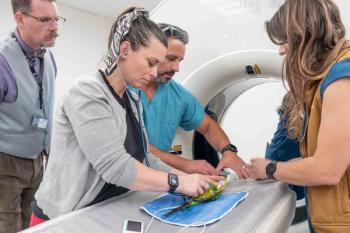
Should you refer for an ultrasound?
You don't have an ultrasound machine in your practice yet, but you're thinking that it might be ideal for that case that just walked into your door. Here's one imaging expert's guidance on which cases are mostly likely to yield diagnostic results.
Ultrasonographic examinations are becoming more commonplace in veterinary medicine and can be a useful tool in certain situations. In managing an owner's expectations, it is crucial to communicate that most ultrasonographic findings are nonspecific, and additional diagnostic steps are often required to obtain a definitive diagnosis.
“Before you go …”
It is best practice to instruct owners to fast the patient before an ultrasonographic examination. This prevents a food-filled stomach from obscuring visualization of the abdomen and also allows for safe use of sedation if deemed necessary.
First: inpatient or outpatient?
From an imaging perspective, an outpatient is a patient being referred exclusively for an imaging diagnosis. This situation is ideal for clients looking to follow up with their regular veterinarian for further diagnostics or treatment. Ideal cases often include disease of acute onset, with a suspected therapeutic or surgical intervention in mind.
Sedation will likely not be given for outpatient cases; thus, fractious, uncooperative, aggressive patients are best suited for inpatient referral. This allows time for a complete examination of the pet and adequate observation after the use of sedation, anesthesia or both.
Alternatively, an inpatient is simply one that has met with, and been examined by, a doctor in the referral practice. Although this may yield a more thorough and complete consultation-and may allow use of medications, intervention and treatments-this type of referral tends to be more costly. Ideal cases are those with chronic or multisystemic disease, where differentiation of subtle changes may require more diagnostics.
Some specialty practices offer a mixed model in which a patient is referred exclusively for diagnostic imaging but receives a brief physical examination and assessment by a specialty practice doctor so that sedation or anesthesia can be performed. A discussion with the specialty center before referral will help determine which imaging modality and referral type is best for an individual patient.
Into a patient's particulars
Hazy hepatic findings. Evaluating the liver is likely the least appropriate outpatient referral case since 80% of cases leave outpatient imaging for hepatic disease without a diagnosis. There is a great deal of overlap in the ultrasound appearance of hepatic disease, and a biopsy or aspirate is often required to establish a definitive diagnosis. Exceptions would be gallbladder and biliary disease (e.g. gallbladder mucocele, cholelithiasis, obstruction) in which abdominal ultrasonography may be a definitive test (Figure 1). Patients with suspected portosystemic shunts should be referred for inpatient ultrasonography since they may require sedation or further diagnostic tests.
Figure 1. A gallbladder mucocele. (Images courtesy of Dr. King)A suspect spleen. Ultrasonography of the spleen is most often performed to detect a mass. However, it can be difficult to assess whether the mass is benign or malignant with ultrasonography, and rarely can a definitive diagnosis be reached without further diagnostics (e.g. fine-needle aspiration, biopsy). Often, however, the definitive presence of a mass lesion is enough for owners to make a decision about a next step (e.g. surgery).
An unruly urinary system. Suspected ureteroliths, cystoliths, pyelonephritis, ectopic ureters, prostatic abscesses and cysts make ideal referral ultrasonography cases. A definitive diagnosis can often be reached based on imaging findings.
A dubious digestive system. The utility of ultrasonographic examination of the gastrointestinal tract varies. Foreign bodies can be the most straightforward diagnosis (Figure 2), whereas inflammatory and neoplastic diseases are the least straightforward because of the overlap in ultrasonographic appearance. Generally, further testing in the way of ultrasound-guided diagnostic techniques, endoscopy or laparoscopic or abdominal exploratory surgery may be necessary to distinguish between these two diseases and to differentiate the types of neoplasia.
Figure 2. A linear foreign body.A challenging chest. Since it is impractical to examine the entire thorax ultrasonographically, a targeted approach based on radiographic findings is usually used. Although pleural effusion is easily detected and characterized, rarely is a definitive cause found on ultrasonography. Pulmonary nodules may be detected if they are located peripherally. In these cases, ultrasonography is used to help guide fine-needle aspiration or biopsy to help make a definitive diagnosis.
Ryan King, DVM, DACVR, is an assistant professor at the Cummings School of Veterinary Medicine at Tufts University in North Grafton, Massachusetts, and TuftsVETS in Walpole, Massachusetts.
When attending a CE conference, you might just spot Dr. King on his bike. He takes it with him to every conference he attends, including cross country. As Dr. King says, “There is no better way to see a new city than to see its green space in the morning!” He snapped the pic below recently at the ACVIM conference in Denver.
Newsletter
From exam room tips to practice management insights, get trusted veterinary news delivered straight to your inbox—subscribe to dvm360.






